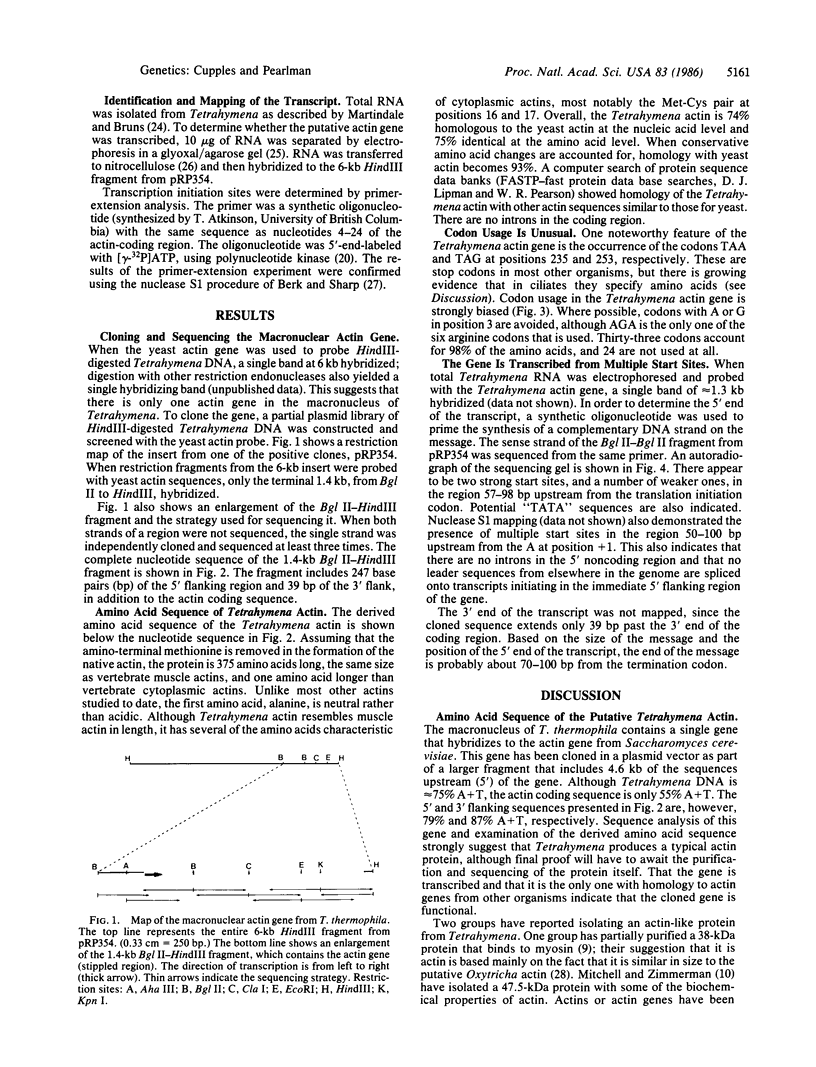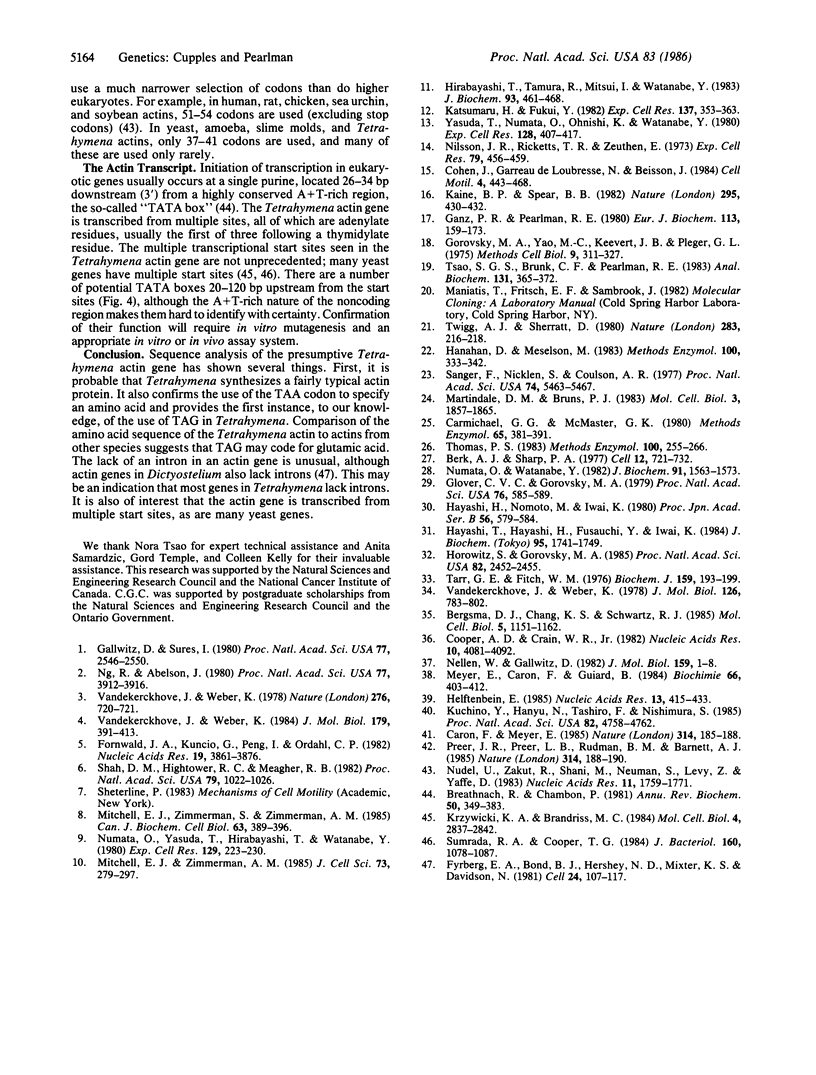Abstract
The macronucleus of Tetrahymena thermophila contains a single actin gene. We have isolated this gene from a partial plasmid library by using the yeast actin gene as a probe. The nucleotide sequence of the gene has been determined and the amino acid sequence of the potential protein deduced. The encoded protein is 375 amino acids long, one amino acid longer than the yeast actin. It is one of the most divergent actins sequenced to date, being only 75% homologous to yeast actin. Unlike the actin genes from most other organisms, it does not contain introns. The coding region contains TAA and TAG codons; the translation termination codon is TGA. Comparison of the amino acid sequence of the Tetrahymena actin with that of actins from other organisms suggests that TAG may code for glutamic acid. The gene is transcribed from multiple initiation sites between 57 and 98 nucleotides upstream of the translation start codon. The 5′ flanking region is very A+T-rich and contains numerous “TATA-like” sequences upstream of the transcription start sites.
Keywords: ciliates, codon usage, transcription
Full text
PDF




Images in this article
Selected References
These references are in PubMed. This may not be the complete list of references from this article.
- Bergsma D. J., Chang K. S., Schwartz R. J. Novel chicken actin gene: third cytoplasmic isoform. Mol Cell Biol. 1985 May;5(5):1151–1162. doi: 10.1128/mcb.5.5.1151. [DOI] [PMC free article] [PubMed] [Google Scholar]
- Berk A. J., Sharp P. A. Sizing and mapping of early adenovirus mRNAs by gel electrophoresis of S1 endonuclease-digested hybrids. Cell. 1977 Nov;12(3):721–732. doi: 10.1016/0092-8674(77)90272-0. [DOI] [PubMed] [Google Scholar]
- Breathnach R., Chambon P. Organization and expression of eucaryotic split genes coding for proteins. Annu Rev Biochem. 1981;50:349–383. doi: 10.1146/annurev.bi.50.070181.002025. [DOI] [PubMed] [Google Scholar]
- Carmichael G. G., McMaster G. K. The analysis of nucleic acids in gels using glyoxal and acridine orange. Methods Enzymol. 1980;65(1):380–391. doi: 10.1016/s0076-6879(80)65049-6. [DOI] [PubMed] [Google Scholar]
- Caron F., Meyer E. Does Paramecium primaurelia use a different genetic code in its macronucleus? Nature. 1985 Mar 14;314(6007):185–188. doi: 10.1038/314185a0. [DOI] [PubMed] [Google Scholar]
- Cohen J., Garreau de Loubresse N., Beisson J. Actin microfilaments in paramecium: localization and role in intracellular movements. Cell Motil. 1984;4(6):443–468. doi: 10.1002/cm.970040605. [DOI] [PubMed] [Google Scholar]
- Cooper A. D., Crain W. R., Jr Complete nucleotide sequence of a sea urchin actin gene. Nucleic Acids Res. 1982 Jul 10;10(13):4081–4092. doi: 10.1093/nar/10.13.4081. [DOI] [PMC free article] [PubMed] [Google Scholar]
- Fornwald J. A., Kuncio G., Peng I., Ordahl C. P. The complete nucleotide sequence of the chick a-actin gene and its evolutionary relationship to the actin gene family. Nucleic Acids Res. 1982 Jul 10;10(13):3861–3876. doi: 10.1093/nar/10.13.3861. [DOI] [PMC free article] [PubMed] [Google Scholar]
- Fyrberg E. A., Bond B. J., Hershey N. D., Mixter K. S., Davidson N. The actin genes of Drosophila: protein coding regions are highly conserved but intron positions are not. Cell. 1981 Apr;24(1):107–116. doi: 10.1016/0092-8674(81)90506-7. [DOI] [PubMed] [Google Scholar]
- Gallwitz D., Sures I. Structure of a split yeast gene: complete nucleotide sequence of the actin gene in Saccharomyces cerevisiae. Proc Natl Acad Sci U S A. 1980 May;77(5):2546–2550. doi: 10.1073/pnas.77.5.2546. [DOI] [PMC free article] [PubMed] [Google Scholar]
- Ganz P. R., Pearlman R. E. Purification from Tetrahymena thermophila of DNA polymerase and a protein which modifies its activity. Eur J Biochem. 1980 Dec;113(1):159–173. doi: 10.1111/j.1432-1033.1980.tb06151.x. [DOI] [PubMed] [Google Scholar]
- Glover C. V., Gorovsky M. A. Amino-acid sequence of Tetrahymena histone H4 differs from that of higher eukaryotes. Proc Natl Acad Sci U S A. 1979 Feb;76(2):585–589. doi: 10.1073/pnas.76.2.585. [DOI] [PMC free article] [PubMed] [Google Scholar]
- Gorovsky M. A., Yao M. C., Keevert J. B., Pleger G. L. Isolation of micro- and macronuclei of Tetrahymena pyriformis. Methods Cell Biol. 1975;9(0):311–327. doi: 10.1016/s0091-679x(08)60080-1. [DOI] [PubMed] [Google Scholar]
- Hanahan D., Meselson M. Plasmid screening at high colony density. Methods Enzymol. 1983;100:333–342. doi: 10.1016/0076-6879(83)00066-x. [DOI] [PubMed] [Google Scholar]
- Hayashi T., Hayashi H., Fusauchi Y., Iwai K. Tetrahymena histone H3. Purification and two variant sequences. J Biochem. 1984 Jun;95(6):1741–1749. doi: 10.1093/oxfordjournals.jbchem.a134788. [DOI] [PubMed] [Google Scholar]
- Helftenbein E. Nucleotide sequence of a macronuclear DNA molecule coding for alpha-tubulin from the ciliate Stylonychia lemnae. Special codon usage: TAA is not a translation termination codon. Nucleic Acids Res. 1985 Jan 25;13(2):415–433. doi: 10.1093/nar/13.2.415. [DOI] [PMC free article] [PubMed] [Google Scholar]
- Hirabayashi T., Tamura R., Mitsui I., Watanabe Y. Investigation of actin in Tetrahymena cells. A comparison with skeletal muscle actin by a devised two-dimensional gel electrophoresis method. J Biochem. 1983 Feb;93(2):461–468. doi: 10.1093/oxfordjournals.jbchem.a134200. [DOI] [PubMed] [Google Scholar]
- Horowitz S., Gorovsky M. A. An unusual genetic code in nuclear genes of Tetrahymena. Proc Natl Acad Sci U S A. 1985 Apr;82(8):2452–2455. doi: 10.1073/pnas.82.8.2452. [DOI] [PMC free article] [PubMed] [Google Scholar]
- Kaine B. P., Spear B. B. Nucleotide sequence of a macronuclear gene for actin in Oxytricha fallax. Nature. 1982 Feb 4;295(5848):430–432. doi: 10.1038/295430a0. [DOI] [PubMed] [Google Scholar]
- Katsumaru H., Fukui Y. In vivo identification of Tetrahymena actin probed by DMSO induction nuclear bundles. Exp Cell Res. 1982 Feb;137(2):353–363. doi: 10.1016/0014-4827(82)90036-2. [DOI] [PubMed] [Google Scholar]
- Krzywicki K. A., Brandriss M. C. Primary structure of the nuclear PUT2 gene involved in the mitochondrial pathway for proline utilization in Saccharomyces cerevisiae. Mol Cell Biol. 1984 Dec;4(12):2837–2842. doi: 10.1128/mcb.4.12.2837. [DOI] [PMC free article] [PubMed] [Google Scholar]
- Kuchino Y., Hanyu N., Tashiro F., Nishimura S. Tetrahymena thermophila glutamine tRNA and its gene that corresponds to UAA termination codon. Proc Natl Acad Sci U S A. 1985 Jul;82(14):4758–4762. doi: 10.1073/pnas.82.14.4758. [DOI] [PMC free article] [PubMed] [Google Scholar]
- Martindale D. W., Bruns P. J. Cloning of abundant mRNA species present during conjugation of Tetrahymena thermophila: identification of mRNA species present exclusively during meiosis. Mol Cell Biol. 1983 Oct;3(10):1857–1865. doi: 10.1128/mcb.3.10.1857. [DOI] [PMC free article] [PubMed] [Google Scholar]
- Meyer E., Caron F., Guiard B. Blocking of in vitro translation of Paramecium messenger RNAs is due to messenger RNA primary structure. Biochimie. 1984 May;66(5):403–412. doi: 10.1016/0300-9084(84)90024-5. [DOI] [PubMed] [Google Scholar]
- Mitchell E. J., Zimmerman A. M. Biochemical evidence for the presence of an actin protein in Tetrahymena pyriformis. J Cell Sci. 1985 Feb;73:279–297. doi: 10.1242/jcs.73.1.279. [DOI] [PubMed] [Google Scholar]
- Mitchell E. J., Zimmerman S., Zimmerman A. M. Actin and tubulin in Tetrahymena. Can J Biochem Cell Biol. 1985 Jun;63(6):389–396. doi: 10.1139/o85-058. [DOI] [PubMed] [Google Scholar]
- Nellen W., Gallwitz D. Actin genes and actin messenger RNA in Acanthamoeba castellanii. Nucleotide sequence of the split actin gene I. J Mol Biol. 1982 Jul 25;159(1):1–18. doi: 10.1016/0022-2836(82)90028-6. [DOI] [PubMed] [Google Scholar]
- Ng R., Abelson J. Isolation and sequence of the gene for actin in Saccharomyces cerevisiae. Proc Natl Acad Sci U S A. 1980 Jul;77(7):3912–3916. doi: 10.1073/pnas.77.7.3912. [DOI] [PMC free article] [PubMed] [Google Scholar]
- Nilsson J. R., Ricketts T. R., Zeuthen E. Effects of cytochalasin B on cell division and vacuole formation in Tetrahymena pyriformis GL. Exp Cell Res. 1973 Jun;79(2):456–459. doi: 10.1016/0014-4827(73)90468-0. [DOI] [PubMed] [Google Scholar]
- Nudel U., Zakut R., Shani M., Neuman S., Levy Z., Yaffe D. The nucleotide sequence of the rat cytoplasmic beta-actin gene. Nucleic Acids Res. 1983 Mar 25;11(6):1759–1771. doi: 10.1093/nar/11.6.1759. [DOI] [PMC free article] [PubMed] [Google Scholar]
- Numata O., Watanabe Y. In vitro assembly and disassembly of 14-nm filament from Tetrahymena pyriformis. The protein component of 14-nm filament is a 49,000-Dalton protein. J Biochem. 1982 May;91(5):1563–1573. doi: 10.1093/oxfordjournals.jbchem.a133847. [DOI] [PubMed] [Google Scholar]
- Numata O., Yasuda T., Hirabayashi T., Watanabe Y. A new fiber-forming protein from Tetrahymena pyriformis. Exp Cell Res. 1980 Sep;129(1):223–230. doi: 10.1016/0014-4827(80)90345-6. [DOI] [PubMed] [Google Scholar]
- Preer J. R., Jr, Preer L. B., Rudman B. M., Barnett A. J. Deviation from the universal code shown by the gene for surface protein 51A in Paramecium. Nature. 1985 Mar 14;314(6007):188–190. doi: 10.1038/314188a0. [DOI] [PubMed] [Google Scholar]
- Sanger F., Nicklen S., Coulson A. R. DNA sequencing with chain-terminating inhibitors. Proc Natl Acad Sci U S A. 1977 Dec;74(12):5463–5467. doi: 10.1073/pnas.74.12.5463. [DOI] [PMC free article] [PubMed] [Google Scholar]
- Shah D. M., Hightower R. C., Meagher R. B. Complete nucleotide sequence of a soybean actin gene. Proc Natl Acad Sci U S A. 1982 Feb;79(4):1022–1026. doi: 10.1073/pnas.79.4.1022. [DOI] [PMC free article] [PubMed] [Google Scholar]
- Sumrada R. A., Cooper T. G. Nucleotide sequence of the Saccharomyces cerevisiae arginase gene (CAR1) and its transcription under various physiological conditions. J Bacteriol. 1984 Dec;160(3):1078–1087. doi: 10.1128/jb.160.3.1078-1087.1984. [DOI] [PMC free article] [PubMed] [Google Scholar]
- Tarr G. E., Fitch W. M. Amino acid sequence of cytochrome c from Tetrahymena pyriformis Phenoset A. Biochem J. 1976 Nov;159(2):193–199. doi: 10.1042/bj1590193. [DOI] [PMC free article] [PubMed] [Google Scholar]
- Thomas P. S. Hybridization of denatured RNA transferred or dotted nitrocellulose paper. Methods Enzymol. 1983;100:255–266. doi: 10.1016/0076-6879(83)00060-9. [DOI] [PubMed] [Google Scholar]
- Tsao S. G., Brunk C. F., Pearlman R. E. Hybridization of nucleic acids directly in agarose gels. Anal Biochem. 1983 Jun;131(2):365–372. doi: 10.1016/0003-2697(83)90185-9. [DOI] [PubMed] [Google Scholar]
- Twigg A. J., Sherratt D. Trans-complementable copy-number mutants of plasmid ColE1. Nature. 1980 Jan 10;283(5743):216–218. doi: 10.1038/283216a0. [DOI] [PubMed] [Google Scholar]
- Vandekerckhove J., Weber K. At least six different actins are expressed in a higher mammal: an analysis based on the amino acid sequence of the amino-terminal tryptic peptide. J Mol Biol. 1978 Dec 25;126(4):783–802. doi: 10.1016/0022-2836(78)90020-7. [DOI] [PubMed] [Google Scholar]
- Vandekerckhove J., Weber K. Chordate muscle actins differ distinctly from invertebrate muscle actins. The evolution of the different vertebrate muscle actins. J Mol Biol. 1984 Nov 5;179(3):391–413. doi: 10.1016/0022-2836(84)90072-x. [DOI] [PubMed] [Google Scholar]
- Vandekerckhove J., Weber K. The amino acid sequence of Physarum actin. Nature. 1978 Dec 14;276(5689):720–721. doi: 10.1038/276720a0. [DOI] [PubMed] [Google Scholar]
- Yasuda T., Numata O., Ohnishi K., Watanabe Y. A contractile ring and cortical changes found in the dividing Tetrahymena pyriformis. Exp Cell Res. 1980 Aug;128(2):407–417. doi: 10.1016/0014-4827(80)90076-2. [DOI] [PubMed] [Google Scholar]




